교차 원통형 흐름: 압력 분포 측정 및 항력 계수 추정
Overview
출처: 데이비드 구오, 공학, 기술 및 항공 대학 (CETA), 서던 뉴 햄프셔 대학 (SNHU), 맨체스터, 뉴햄프셔
교차 원통형 흐름에 대한 압력 분포 및 드래그 추정은 수세기 동안 조사되었습니다. 이상적으로 는 잠재적 흐름 이론에 의하면 실린더 주변의 압력 분포는 수직대칭입니다. 실린더의 압력 분포상류와 하류도 대칭으로 제로네트 드래그 력을 생성합니다. 그러나 실험 결과는 매우 다른 흐름 패턴, 압력 분포 및 드래그 계수를 산출합니다. 이는 이상적인 무의미한 잠재적 이론이 관제 흐름을 가정하기 때문에 흐름 패턴을 결정할 때 점도가 고려되거나 고려되지 않기 때문입니다. 이것은 현실과 크게 다릅니다.
이 데모에서는 풍동이 지정된 공기 속도를 생성하는 데 활용되며, 압력 포트가 24개인 실린더를 사용하여 압력 분포 데이터를 수집합니다. 이 데모는 원형 실린더 주위를 흐르는 실제 유체의 압력이 이상적인 유체의 잠재적 흐름에 따라 예측된 결과와 어떻게 다른지 보여줍니다. 드래그 계수도 예상값과 비교하여 추정됩니다.
Principles
비차원 압력 계수, Cp,임의의 각도 위치에서 이상적인 잠재적 흐름 이론의 임의 위치에 대한, θ, 원형 실린더의 표면에 다음 방정식에 의해 주어진다:

압력 계수 Cp는 다음과 같이 정의됩니다.

P가 절대 압력인 경우 P∞는 방해받지 않는 자유 스트림 압력, P게이지 = P - P ∞ 게이지  압력이며, 자유 스트림 밀도, ∞,및 공기 속도, V∞기반의 동적 압력입니다.
압력이며, 자유 스트림 밀도, ∞,및 공기 속도, V∞기반의 동적 압력입니다.
이상적인 잠재적 흐름 이론에 의해 예측된 유동 패턴은 도 1에표시됩니다. 흐름은 대칭이므로 순 드래그 힘이 0입니다. 이를 D'Alembert의 역설 [1]이라고 합니다.
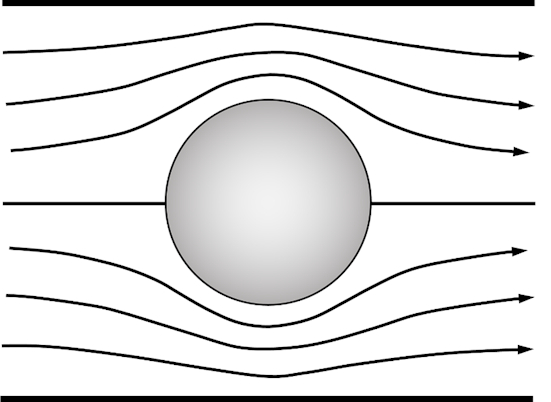
그림 1. 풍동에서 이상적인 교차 원통형 흐름의 흐름 패턴.
그러나 실제 흐름 조건에서는 순 제로 드래그 힘이 예상되지 않습니다. 압력 차이로 인해 실린더의 단위 길이당 인FD의드래그 힘은 다음과 같은 것입니다.

통합은 실린더의 둘레를 따라 수행됩니다.
이 실험에서는 실린더를 따라 24개의 압력 포트에서 게이지 압력 측정이 수집됩니다. 그런 다음 위의 방정식은 측정된 게이지 압력을 사용하여 다음과 같이 수치적으로 평가될 수 있습니다.

여기서 P게이지i는 θi의위치에 게이지 압력이고, θi는 각 위치이고, r은 실린더의 반지름이며,  θ는 15°인 인접한 포트 사이의 각도 거리이다. 게이지 압력은 24개의 독립적인 컬럼이 있는 기마계 패널을 사용하여 결정되며, 게이지 압력은 다음 방정식을 사용하여 결정됩니다.
θ는 15°인 인접한 포트 사이의 각도 거리이다. 게이지 압력은 24개의 독립적인 컬럼이 있는 기마계 패널을 사용하여 결정되며, 게이지 압력은 다음 방정식을 사용하여 결정됩니다.

여기서 Δh는 자유 스트림 압력을 참조하여 기마계의 높이 차이인 경우, Lθ는 기마계내의 액체밀도이며, g는 중력으로 인한 가속이다. 드래그 포스를 얻으면 비차원 드래그 계수 CD를 통해 결정할 수 있습니다.

여기서 d = 2r는 실린더의 직경입니다.
달렘베르트의 역설을 기억, 드래그 힘은 점도의 무시 효과 때문입니다. 첫째, 점성 힘의 결과로 원통을 따라 경계 층이 발생합니다. 이러한 점성 힘은 피부 마찰 드래그를 유발합니다. 둘째, 실린더는 절벽(간소화되지 않은) 오브젝트입니다. 이렇게 하면 유동 분리와 저압 절전 모드가 생성되고 압력 차이로 인해 더 큰 항력이 발생합니다. 도 2는 실험적으로 관찰되는 몇 가지 일반적인 흐름 패턴을 표시합니다. 실제 흐름 패턴은 다음과 같이 정의된 레이놀즈 번호 Re에 의존합니다.

매개 변수μ 유체의 동적 점도입니다.
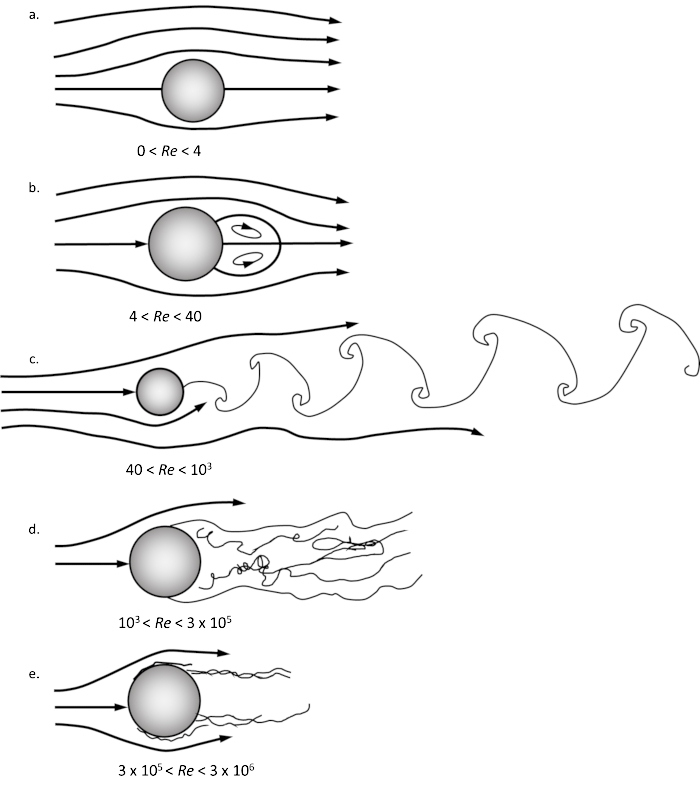
그림 2. 실린더를 통해 다양한 유형의 흐름 패턴.
Procedure
1. 실린더 주위의 압력 분포 측정
- 풍동의 테스트 섹션의 상단 덮개를 제거하고 턴테이블(그림3)에24개의 내장 포트가 있는 깨끗한 알루미늄 실린더(d = 4인치)를 장착합니다. 포트 0이 업스트림을 향할 수 있도록 실린더를 설치합니다(그림4a).
- 상단 덮개를 교체하고 0 - 23이라고 표시된 24개의 압력 튜브를 기마계 패널의 해당 포트에 연결합니다. 기마계 패널은 유색 기름으로 채워져야하지만 물에 표시해야합니다.
- 풍전을 켜고 60mph에서 실행합니다. 기마계를 읽으면서 24개의 압력 측정을 모두 기록합니다. 이 비행 속도에서 레이놀즈 번호는 1.78 x 105입니다. 예상 유동 패턴은 도 2d에표시됩니다.
- 모든 측정값이 기록되면 윈드 터널을 끄고 실린더에서 두 개의 문자열(d = 1mm)을 수직으로 테이프로 돌려 방해된 실린더를 만듭니다. 포트 3과 4(θ = 52.5°) 및 포트 20과 21(θ = 307.5°) 사이에 하나의 문자열을 테이프로 묶습니다. 그림 4b에표시된 대로 근처의 포트가 테이프에 의해 차단되지 않았는지 확인합니다.
- 풍구를 켜고 3단계를 반복합니다. 모든 압력 측정을 기록합니다.
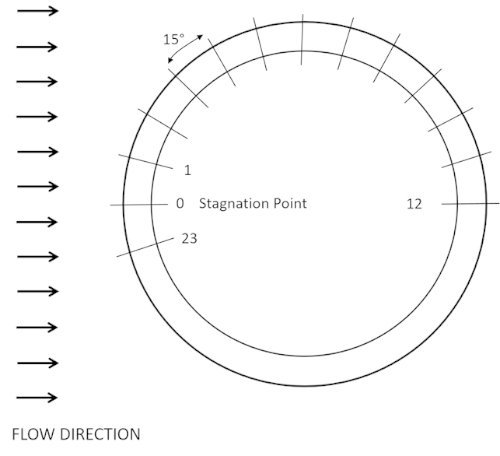
그림 3. 교차 원통형 흐름의 게이지 압력 측정 레이아웃.
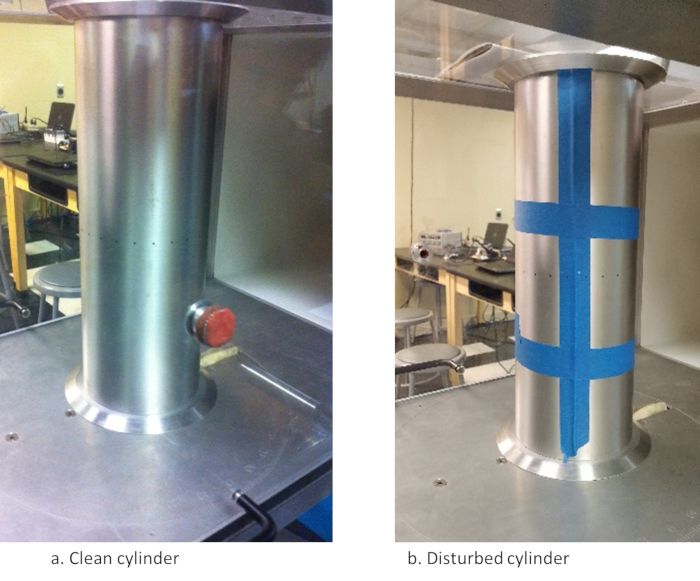
그림 4. 풍터널에 실린더를 설치합니다(압력 포트는 실린더 의 중간에 있음).
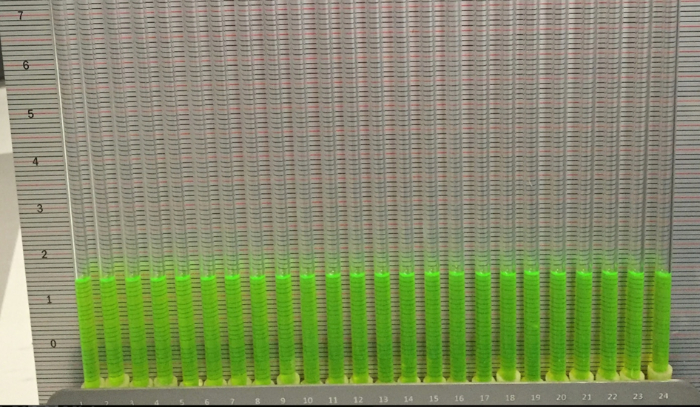
그림 5. 기마계 패널.
Results
깨끗하고 방해된 실린더에 대한 실험 결과는 각각 표 1과 2에표시됩니다. 데이터는 도 6에도시된 바와 같이 이상적이고 실제 흐름을 위해 압력 계수, Cp,각도 위치, θ 의 그래프로 플롯될 수 있다.
| 압력 포트 # | 위치 각도 q(°) | 기마계 판독값의 P게이지(물) | 계산된 압력 계수 Cp |
| 0 | 0 | 1.7 | 1.00 |
| 1 | 15 | 1.4 | 0.83 |
| 2 | 30 | 0.0 | 0.01 |
| 3 | 45 | -1.7 | -0.98 |
| 4 | 60 | -2.7 | -1.57 |
| 5 | 75 | -3.7 | -2.15 |
| 6 | 90 | -3.3 | -1.92 |
| 7 | 105 | -3.0 | -1.74 |
| 8 | 120 | -3.2 | -1.86 |
| 9 | 135 | -3.2 | -1.86 |
| 10 | 150 | -3.3 | -1.92 |
| 11 | 165 | -3.5 | -2.03 |
| 12 | 180 | -3.4 | -1.97 |
표 1. 클린 실린더에 대한 실험 결과. 대칭으로 인해 포트 번호 0-12에 대한 데이터만 표시됩니다.
| 압력 포트 # | 위치 각도 q(°) | 기마계 판독값의 P게이지(물) | 계산된 압력 계수 Cp |
| 0 | 0 | 1.8 | 1.05 |
| 1 | 15 | 1.6 | 0.93 |
| 2 | 30 | 0.6 | 0.35 |
| 3 | 45 | -1.3 | -0.73 |
| 4 | 60 | -2.9 | -1.69 |
| 5 | 75 | -4.0 | -2.31 |
| 6 | 90 | -4.0 | -2.33 |
| 7 | 105 | -1.7 | -0.99 |
| 8 | 120 | -1.5 | -0.89 |
| 9 | 135 | -1.4 | -0.84 |
| 10 | 150 | -1.4 | -0.84 |
| 11 | 165 | -1.5 | -0.87 |
| 12 | 180 | -1.4 | -0.84 |
표 2. 방해된 실린더에 대한 실험 결과. 대칭으로 인해 포트 번호 0-12에 대한 데이터만 표시됩니다.
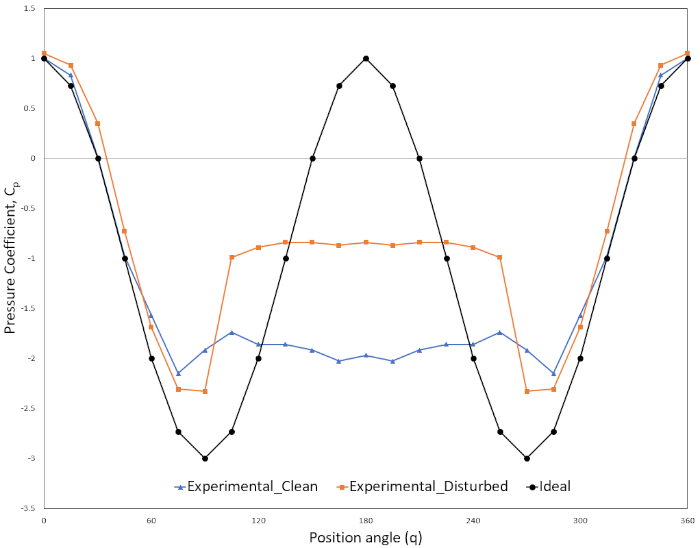
그림 6. 압력 계수 분포, Cp,대 각 위치, θ, 이상적 및 실제 흐름 사이.
정체 점, θ = 0°에서 Cp는 Cp = 1의 최대 값에 도달합니다. 60°< θ의 경우 압력 계수 분포는 세 곡선 모두에 대해 유사합니다. 여기서 라미나르 경계 층 흐름이 실린더 표면에 부착됩니다. 60°> θ의 경우, 두 개의 실험적 흐름 패턴은 이상적인 흐름에서 벗어난다. 그들은 난류 소용돌이와 에디로 가득 실린더의 뒷면에 저압 영역을 형성한다. 이 영역이라고 합니다. 원통형 의 전방과 후면 사이의 압력 차가 교차 원통형 흐름에서 관찰되는 큰 드래그를 일으킨다.
깨끗한 실린더와 방해실린더 사이의 흐름 패턴의 유사성에도 불구하고 차이점도 있습니다. 방해된 흐름은 유동 분리 전에 실린더 를 감싸는 경향이 있으며, 또한 더 높은 역압을 가지고 있습니다. 이렇게 하면 드래그 계산에서 확인된 드래그가 줄어듭니다. 이는 실린더 앞의 라미나르 흐름이 직선으로 흐르는 경향이 있고 흐름이 실린더 주위를 감싸기 어렵기 때문에 발생합니다. 방해된 실린더의 경우 흐름은 즉시 난류 흐름으로 전환되므로 클린 실린더보다 실린더 를 감싸수 있습니다.
| 흐름 구성 | 드래그 계수, CD |
| 1. 클린 실린더 | 1.68 |
| 2. 방해 실린더 | 0.78 |
표 4. 드래그 계수, CD (레이놀즈 번호 Re = 1.78 x 105).
60mph 기속 또는 Re=178,000에서 클린 실린더용 드래그 계수 CD는 실험적으로 평가되었으며 약 1.5 [2]이며, 이는 이 실험에서 얻은 1.68의 값에 가깝습니다.
이전 실험 결과 [2]에서 드래그 계수 CD는 Re = 3 x 105에서떨어집니다. 이는 라미나르 흐름에서 격동의 흐름으로의 전환이 매끄러운 실린더에서도 자연스럽게 발생하기 때문입니다. 실험에서, 난류 흐름 전이는 단순히 실린더의 표면에 1mm 직경 문자열을 테이핑하여 관찰된다. 따라서, 0.78의 낮은 드래그 계수 CD는 방해실린더에 대해 얻어진다.
Application and Summary
교차 원통형 흐름은 18 세기부터 이론적으로 그리고 실험적으로 조사되었습니다. 둘 사이의 불일치를 찾아서 유체 역학에 대한 이해를 확장하고 새로운 방법론을 탐구할 수 있습니다. 경계 층 흐름 이론은 20 세기 초에 Prandtl [3]에 의해 개발되었으며, D'Alembert의 역설을 해결하기위한 비스타드 흐름 이론으로 비스티드 흐름의 확장의 좋은 예입니다.
본 실험에서, 교차 원통형 흐름은 풍동에서 조사되었고, 24개의 압력 측정 포트가 실린더의 표면을 따라 압력 분포를 찾아서 이루어졌다. 드래그 계수는 계산되었으며 다른 소스와 잘 동의합니다. 상대적으로 낮은 레이놀즈 수로 난류 경계 흐름을 트리거하는 흐름의 조작도 입증되었다.
References
- d'Alembert, Jean le Rond (1752), Essai d'une nouvelle théorie de la résistance des fluides
- John D. Anderson (2017), Fundamentals of Aerodynamics, 6th Edition, ISBN: 978-1-259-12991-9, McGraw-Hill
- Prandtl, Ludwig (1904), Motion of fluids with very little viscosity, 452, NACA Technical Memorandum
Tags
건너뛰기...
이 컬렉션의 비디오:

Now Playing
교차 원통형 흐름: 압력 분포 측정 및 항력 계수 추정
Aeronautical Engineering
16.2K Views

모형 항공기의 공기 역학적 성능: DC-6B
Aeronautical Engineering
8.3K Views

프로펠러 특성: 성능 관련 피치, 직경 및 블레이드 수의 변화
Aeronautical Engineering
26.4K Views

에어포일 동작: Clark Y-14 날개의 압력 분포
Aeronautical Engineering
21.2K Views

Clark Y-14 날개 성능: 고양력 장치 (플랩 및 슬랫) 적용
Aeronautical Engineering
13.4K Views

난류 구체 방식: 풍동 흐름 품질 평가
Aeronautical Engineering
8.7K Views

노즐 분석: 수렴 및 수렴 전달 노즐에 따른 마하수 및 압력의 변화
Aeronautical Engineering
38.0K Views

슐리렌 이미징: 초음속 흐름 특징을 시각화하는 기술
Aeronautical Engineering
11.7K Views

회류 수조 흐름 시각화: 델타 날개 위 첨단 소용돌이 관찰
Aeronautical Engineering
8.2K Views

표면 염료 흐름 시각화: 초음속 흐름 내 흐름맥 패턴을 관찰하는 정성적 방법
Aeronautical Engineering
4.9K Views

피트 정압관: 풍량 측정 장치
Aeronautical Engineering
49.2K Views

항온 풍속 측정: 난류 경계층 흐름 연구 도구
Aeronautical Engineering
7.3K Views

압력 변환기: 피트 정압관을 사용한 보정
Aeronautical Engineering
8.5K Views

실시간 비행 제어: 임베디드 센서 교정 및 데이터 수집
Aeronautical Engineering
10.3K Views

멀티콥터 공기역학: 헥사콥터 추력 특성화
Aeronautical Engineering
9.1K Views
Copyright © 2025 MyJoVE Corporation. 판권 소유